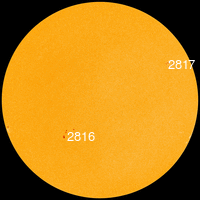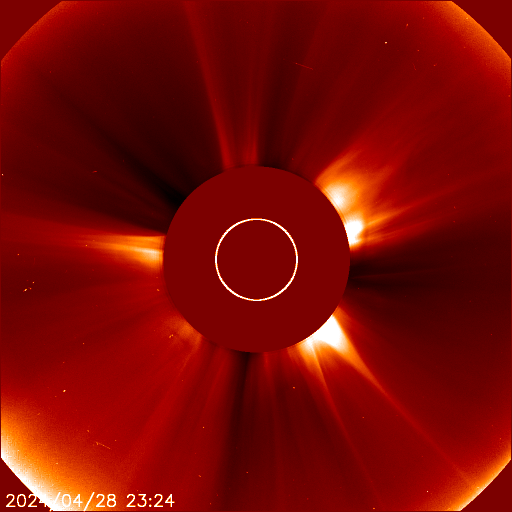Mars Helicopter takes Flight!
The Ingenuity rovercraft has taken flight in the thin atmosphere of Mars, and it has looked down upon its shadow. It’s almost poetic that a tiny swatch of muslin fabric from the Wright Brother’s Flyer I is attached to the underside of Ingenuity’s solar panels. I’m so excited, I can barely contain myself!
I saw a report on my local news showing a gob-smacked reporter holding one of Ingenuity’s wings, and commenting how paper-light it was; I’d seriously like to see students have that same reaction! NASA should develop some sort of outreach program where teachers can get ahold of an Ingenuity wing replica for their classrooms – I’ve asked my volunteer NASA/JPL Solar System Ambassador contacts if this is possible.

Mars appears above the constellations Orion and Taurus in the western sky after sunset all week.

The Moon appears near the star Regulus high in the southwestern sky after sunset on April 21st and 22nd.

The Moon appears near the star Spica in the southeastern sky after sunset on April 25th.

Jupiter and Saturn appear in the southeastern predawn sky all week.

The sky overhead after sunset (from the northern hemisphere) on April 21st:


The Moon is at First Quarter Moon (April 20th) – it will be visible high in the southern sky in early evening.
After April 20th, the Moon will be a Waxing Gibbous – visible to the southeast in early evening, and up for most of the night. This whole week will be great for telescope observing of the Moon after sunset!

If you click on the Moon image above, or click this link, you will go to NASA’s Moon Phase and Libration, 2021 page – it will show you what the Moon looks like right now. If you click the image on that page, you will download a high-rez TIFF image annotated with the names of prominent features – helpful for logging your lunar observations!
Moon News:


The Sun has 2 spots, and one is blowing flares – a reminder that solar flares can have negative effects on human-made electromagnetic infrastructure:
“M-CLASS SOLAR FLARE: Sunspot AR2816 erupted during the late hours of April 19th (2342 UT), producing a strong M1-class solar flare. NASA’s Solar Dynamics Observatory recorded the extreme ultraviolet flash (see video below).
This is one of the strongest flares of young Solar Cycle 25. A pulse of X-rays and ultraviolet radiation from the flare ionized the top of Earth’s atmosphere, causing a shortwave radio blackout over the Pacific Ocean: blackout map. Mariners and ham radio operators in the area might have noticed unusual propagation conditions at frequencies below 10 MHz.
There is a chance that the explosion also hurled a coronal mass ejection (CME) toward Earth. If so, it would probably arrive on April 22-23. The jury’s still out, though. We need to wait for more data from SOHO coronagraphs to confirm the CME.” – SpaceWeather.com.
Intense coronal loop activity in several spots; the southern coronal hole remains large, and appears to have merged with a larger coronal hole on the Sun’s face – making the southern hole look lop-sided.
Prominences, everywhere! Hedgerow in the lower-right! (I LOVE hedgerow prominences!)
You can view the Sun in near real-time, in multiple frequencies here: SDO-The Sun Now.
You can create your own time-lapse movies of the Sun here: AIA/HMI Browse Data.
You can browse all the SDO images of the Sun from 2010 to the present here: Browse SDO archive.
Solar Activity on Facebook – Run by Volunteer NASA/JPL Solar System Ambassador Pamela Shivak

Solar Corona
Solar wind speed is 583.7 km/sec, with a density of 6.6 protons/cm3 at 1140 UT.
Near real-time animation of the corona and solar wind from the Solar & Heliospheric Observatory (SOHO):

Sun News:

- Near-Earth Objects (NEOs) discovered this month: : 265 this year: 976, all time: 25,791 (+119)
- Potentially hazardous asteroids: 2181 (+5, updated 2021-04-20)
- Total Minor Planets discovered (NASA): 1,075,796 (+2226)
- Total Minor Planets discovered (MPC): 1,043,047 (updated 2021-03-16)
Upcoming Earth-asteroid encounters:
| Asteroid | Date(UT) | Miss Distance | Velocity (km/s) | Diameter (m) |
| 2021 GX7 | 2021-Apr-20 | 6.5 LD | 11 | 16 |
| 2019 HQ | 2021-Apr-20 | 14.8 LD | 8.8 | 20 |
| 2021 HD | 2021-Apr-20 | 10.5 LD | 11.3 | 20 |
| 2021 GJ3 | 2021-Apr-21 | 3.9 LD | 13.5 | 63 |
| 2021 GD3 | 2021-Apr-21 | 10.8 LD | 3.5 | 15 |
| 2021 GZ9 | 2021-Apr-22 | 16 LD | 3.2 | 19 |
| 2021 GO16 | 2021-Apr-22 | 17.2 LD | 12.6 | 50 |
| 2020 HO5 | 2021-Apr-22 | 16.5 LD | 3.3 | 7 |
| 2021 GP4 | 2021-Apr-23 | 18 LD | 8.9 | 35 |
| 2019 PS1 | 2021-Apr-23 | 14.5 LD | 10 | 16 |
| 2016 QE45 | 2021-Apr-24 | 13.2 LD | 15.3 | 162 |
| 2021 HG1 | 2021-Apr-24 | 6.4 LD | 10.3 | 13 |
| 2021 FK3 | 2021-Apr-24 | 15.8 LD | 14 | 119 |
| 2021 GF8 | 2021-Apr-26 | 5.5 LD | 7.1 | 27 |
| 2015 HA177 | 2021-Apr-26 | 19.3 LD | 8.8 | 10 |
| 2019 HF4 | 2021-Apr-26 | 7.8 LD | 6.8 | 11 |
| 2021 GG11 | 2021-Apr-27 | 4.8 LD | 14.8 | 88 |
| 2021 GT9 | 2021-Apr-28 | 10.9 LD | 5.9 | 16 |
| 2021 HQ1 | 2021-Apr-28 | 18.1 LD | 4.5 | 19 |
| 2021 HH | 2021-Apr-29 | 14.4 LD | 16.5 | 33 |
| 2021 HU | 2021-Apr-29 | 9.8 LD | 10.9 | 29 |
| 2021 EZ4 | 2021-Apr-29 | 14.9 LD | 2.5 | 21 |
| 2021 HA | 2021-Apr-30 | 7.8 LD | 5.9 | 26 |
| 2021 HB1 | 2021-Apr-30 | 12.2 LD | 10.7 | 32 |
| 2019 VT3 | 2021-May-01 | 12.1 LD | 5.9 | 8 |
| 2021 HH1 | 2021-May-01 | 16.3 LD | 15.2 | 69 |
| 2021 HT1 | 2021-May-04 | 13.9 LD | 11.2 | 18 |
| 2021 AF8 | 2021-May-04 | 8.8 LD | 9.4 | 344 |
| 2018 JP | 2021-May-05 | 10.7 LD | 7.8 | 12 |
| 2021 AE4 | 2021-May-06 | 18.5 LD | 9.1 | 153 |
| 2021 HF1 | 2021-May-07 | 12.4 LD | 2.8 | 10 |
| 2021 GM10 | 2021-May-10 | 12.7 LD | 5.8 | 36 |
| 2021 GK1 | 2021-May-11 | 1.5 LD | 2 | 13 |
| 2015 KJ19 | 2021-May-14 | 15.1 LD | 23 | 118 |
| 478784 | 2021-May-18 | 15.8 LD | 5 | 27 |
| 2021 FN4 | 2021-May-24 | 6.1 LD | 8.3 | 86 |
| 2013 VO11 | 2021-May-25 | 3.5 LD | 10.2 | 8 |
| 2018 LB | 2021-Jun-01 | 2.9 LD | 7.7 | 22 |
Asteroid News:

On April 5, 2021, the NASA All Sky Fireball Network reported 24 fireballs!
(24 sporadics)

Fireball News:
If you see a bright meteor or a fireball, please REPORT IT to the American Meteor Society and the International Meteor Organization!

Position of the planets & several spacecraft in the inner solar system on April 20th. The Parker Solar Probe will soon be crossing the orbit of Mercury, heading toward perihelion #8 on April 29th. The OSIRIS-REx spacecraft remains nearby asteroid Bennu until May 10th:

Position of the planets in the middle solar system:

Position of the planets, and a several transneptunian objects in the outer solar system.


OSIRIS-REx Asteroid Sample Return Mission:
International Space Station:
HiRISE – on the Mars Reconnaissance Orbiter:
Hubble Space Telescope:
Landsat:
Climate:
See a list of current NASA missions here: https://www.jpl.nasa.gov/missions/?type=current

ex·o·plan·et /ˈeksōˌplanət/, noun: a planet orbiting a star other than the Sun.
Data from the NASA Exoplanet Archive
* Confirmed Planets Discovered by TESS refers to the number planets that have been published in the refereed astronomical literature.
* TESS Project Candidates refers to the total number of transit-like events that appear to be astrophysical in origin, including false positives as identified by the TESS Project.
* TESS Project Candidates Yet To Be Confirmed refers to the number of TESS Project Candidates that have not yet been dispositioned as a Confirmed Planet or False Positive.
Exoplanet News
Visit NASA’s Eyes on Exoplanets site and explore exoplanets in 3D: https://eyes.nasa.gov/apps/exo/#/

SpaceWeather.com Realtime Aurora Gallery: https://spaceweathergallery.com/aurora_gallery.html

Visit an International Dark Sky Park: https://www.darksky.org/our-work/conservation/idsp/parks/
If you live in Michigan, visit the Michigan Dark Skies site: https://sites.lsa.umich.edu/darkskies/

For Teachers:
Hubble – Beautiful Universe: Abell 370
Abell 370 is one of the very first galaxy clusters in which astronomers observed the phenomenon of gravitational lensing, the warping of spacetime by the cluster’s gravitational field that distorts the light from galaxies lying far behind it. This manifests as arcs and streaks in the picture, which are the stretched images of background galaxies. – NASA/ESA.
Zoomable Image of Abell 370: https://esahubble.org/images/heic1711a/zoomable/
Stay safe, be well, and look up!
Software Apps used for this post:
NASA Eyes on the Solar System: an immersive 3D solar system and space mission simulator – free for the PC /MAC. I maintain the unofficial NASA Eyes Facebook page.
SpaceEngine: a free 3D Universe Simulator for Windows. Steam version with VR support available.
Stellarium: a free open source planetarium app for PC/MAC/Linux. It’s a great tool for planning observing sessions. A web-based version of Stellarium is also available.
Section header image credits:
The Sky – Stellarium / Bob Trembley
Observing Target – Turn Left at Orion / M. Skirvin
The Moon – NASA/JPL-Caltech
The Sun – NASA/JPL-Caltech
Asteroids – NASA/JPL-Caltech
Fireballs – Credited to YouTube
Comets – Comet P/Halley, March 8, 1986, W. Liller
The Solar System – NASA Eyes on the Solar System / Bob Trembley
Spacecraft News – NASA Eyes on the Solar System / Bob Trembley
Exoplanets – Space Engine / Bob Trembley
Light Pollution – NASA’s Black Marble
Aurora – Bob Trembley
The Universe – Universe Today



